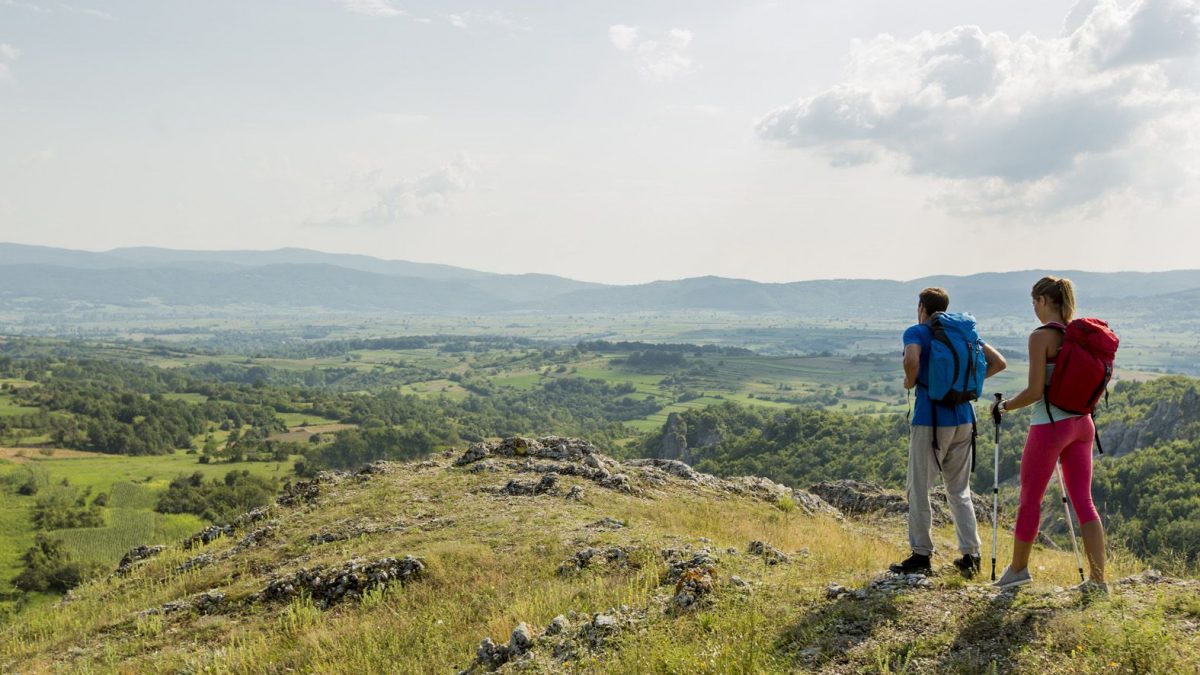Hiking and climbing in Attica

When in Athens, don’t miss the wonderful outdoors opportunity offered by one of the very few capitals around the globe where a great number of hiking and climbing places are concentrated within less than ten minutes driving or walking from the city center.
“The perfect view of Athens from a beautiful mountain! Not to be missed! We visited Mpafi refuge and hiked on Parnitha Mountain. Our guide was A+. He did a great job on sharing with us his knowledge of the mountain. We enjoyed the flowers and the crystal water running straight from the mount spring. In the end, we had the perfect dinner with delicious Greek food and enjoyed the view of the city. Thanks, Mpafi Refuge for a perfect day!!” Merida, Venezuela, Trip advisor
Thanks to the good weather conditions, hiking and climbing in Attica is possible all year round, as the winter in the capital tends to be mild, while during the hot summer months these activities are still pleasant on the several north-facing slopes, sheltered from the summer sun.
It often seems unreal that you can go climbing in one of Europe’s biggest cities.
Characterized for their love of wildlife, hikers and climbers will be quite amazed by the fact that that Attica’s hills and mountains offer shelter to numerous wildlife species: there are 120 species of birds flying around the capital and 140 species of wild flowers recorded in the city itself.
Athens Urban hiking
Athens offers many hiking possibilities even in the city center. To begin with, give your legs a good workout and walk up to Lycabettus Hill. Enjoy a unique hiking experience among pines and olive trees, wild flowers, agaves and prickly pears.
Follow the trail of Greek history and enjoy a magnificent view to the Parthenon, Piraeus port and the sea, when climbing to Areios Pagos hill, where Saint Paul preached the teaching of Christ to the Areopagites, by delivering his famous sermon “about the unknown God” or when climbing to Pnyka, where the famous orators of antiquity as Pericles and Demosthenes spoke before the Assembly in crucial moments of Athens history.
Hiking
Lace up your hiking boots and head out onto the trail exploring Attica Mountains.
Mount Hymettus, within city limits, is a three season mountain since it is rarely covered with snow. It is famous for its thyme-scented honey, its impressive caves and its historical monasteries. Walk on its many marked footpaths and search the traces of the ancient road of Sfittia between Profitis Ilias and Mavrovouni hills. This road was used until the mid-19th century, as the farmers of Koropi would travel daily to Athens to sell their products (mainly olives, grapes, and figs).
Mount Parnitha is the only National Park in Europe so close to a capital (40km.). In its dense vegetation 42 mammals find refuge, among them deer, foxes and many bird species. Two climbing associations, along with the Forest Service of Parnitha have created a network of trails that covers the whole mountain range. Numerous paths pass along springs, thick forests and pastures. Furthermore, there are two mountain refuges, one at Mpafi, owned by the Hellenic Alpine Club of Athens, and the other one at Flampouri, belonging to the Hellenic Alpine Club of Acharnes. Both refuges offer resting and sleeping facilities.
If you are a dreamer, follow the trail to the famous Pan’s cave and, who knows, maybe you will dance with this cloven-hoofed god Pan, who, according to the Greek mythology, used to play his flute and dance in the forests of Mount Parnitha.
Visit Cape Sounion (50 km southeast of Athens) and enjoy a magnificent and easy trail right in the heart of Sounion National Park. You’ll see the impressive gulch of Chaos, the tunnels of the iron mines of the 20th century, and the washing plants of the ancient mines of Lavrion, which raised Classic Athens to a wealthy superpower.
Hiking on a path of culture
In the framework of the Hellenic Society for the Environment and Cultural Heritage Program “Paths of Culture”, the Paths of Greece organization undertook an implementation study of hiking and bicycle trails in the region of Marathon and Schinias, in Attica. The 5 trails pass by several natural and historical monuments (swamp, beach and Aesthetic Forest of Schinias, Makaria spring, Oinoi Gorge, Marathon battle trophy, Tumulus of Marathon, Medieval Tower of Oinoi, Herodus Atticus mansion etc.).
Hiking in the Saronic islands
“The uniqueness of Hydra lies to the combination of the cosmopolitan life with its natural environment and the rich tradition. It is considered an ideal destination for those keen on walking and exploring nature. Given its mild climate, walking in Hydra can be a pleasant experience all year round. With diverse degrees of difficulty, the ten paths presented here should satisfy even the most discriminate adventurer. You can walk the paths easily and at your own pace”. www.hydra.com
“Aegina Island has a beautiful evergreen environment amongst hills and valleys. The ground physiology has contributed to that. Aegina’s hiking trails attract intense touring interest as the visitor can combine hiking, studying the area’s unique flora and fauna, and visiting archaeological places and traditional villages.” www.aegina.com.gr
Spetses: “Lots of people tend to explore the island on foot as no cars are allowed on it. The different paths not only bring the visitor in contact with the nature but also pass from the most important sights of the island.” www. wondergreece.gr
Poros: “Those who love hiking can explore the plush pine inland of Poros island. Discovering the paths through the untouched natural environment, smelling the scent of pine everywhere and admiring the fascinating view of the surrounding area from the hills of the island will be the great reward for those who choose to visit Poros island.” www.poros-portal.gr
Agistri: “For those who love hiking, there are amazing routes that the visitors can explore and get to know with the amazing and ever green natural environment of the island. Hiking at Agistri is easy, with small and pleasant routes. Visitors can enjoy the unparalleled natural beauty of the island.” www.agistri.com.gr
Kythera: “Hiking in Kythera” is an amazing hiking trails network of 50 kilometers. The network is still growing, as many new kilometers of trails are added every year. It is run by the Kytherian Foundation for Culture and Development, and Paths of Greece. www.worldtrailsnetwork.org
Antikythera: Paths of Greece organization cleared and sign-posted a circular 1-hour-walk path, that passes from the most important sites of the fortification. www.pathsofgreece.gr
Climbing
Attica offers endless opportunities as regards to sport climbing with more than 35 crags and 1100 sport routes, of all degrees of difficulty.
You will be surprised to know that there are climbing fields on Lycabettus, Tourkovounia and Filopappou hills in the city itself. Some of them are suitable for climbers of all levels. Try a unique experience and enjoy the amazing view from these three hills.
There are eight climbing fields of all degrees of difficulty on Mount Hymettus.
Mount Parnitha is a must in mountain climbing. Petra Varibombis northeast of the Athens’ Thrakomakedones suburb features a large cluster of rocks of different sizes.
In the gorge of Houni the area of Flambouri offers several climbing possibilities and is considered of medium difficulty, with an altitude difference of 90 meters. An even more challenging area is Arma, above the Monastery of Kleiston, with cliffs that are in the ‘difficult’ range and an altitude difference of 130 meters. www.ecotourism-greece.com
Penteli, one of the four mountains surrounding the city of Athens, offers a variety of sports and traditional climbing on marble. All the crags are abandoned marble quarries of the recent or the distant past. For an exceptional mental and physical challenge, climb on the marble quarry dating back more than 2500 years out of Spilia Daveli. It was there that the marble for Parthenon was extracted.
Mavrosouvala, 45km north of Athens, very close to the Athens-Lamia-Thessaloniki motorway (A1 / E75), is usually referenced as the best sport climbing crag in Athens.
Iera Odos, near Aspropyrgos, is one of the best choices for sport climbing on easy and moderate grades in Attica. On a sunny winter day, it is not uncommon to climb in a summer outfit.
In the Sounion National Park, an impressive natural limestone crater known as “Chaos” is considered one of the best crags in Greece.
Spectacular climbing by the sea.
Athenian seaside crags are well-known for their long and beautiful routes.
Attica: An open invitation to all the mountain and adventure lovers!




